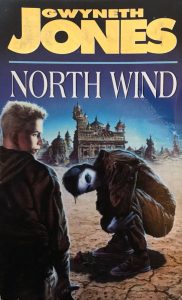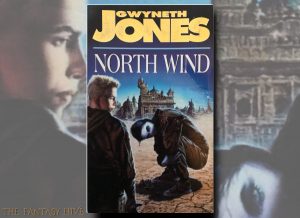NORTH WIND by Gwyneth Jones (BOOK REVIEW)
“Race is bullshit, he said. Culture is everything.”
“’It was the Aleutians,’ said the halfcaste, forgetting to protest that the war wasn’t really about gender. ‘The problem was always there. But everyone believed, deep down, that it couldn’t be solved. Men and women were complementary halves: two sides of the same coin. Then the Aleutians came, and each of them was a person, nobody’s better or worse half. The women saw the aliens: with no one forcing sex on them; having children and not getting their pay docked for the privilege; and so on. The men saw the aliens doing what comes naturally with no thought for the consequences, and nobody having unrealistic expectations or nagging them to behave. They both said to themselves: if the Aleutians don’t have to put up with that shit, why do we? The superbeings made it valid for everybody to be a person. But – cut it any way you like – that means there’s twice as many full-sized humans in any given area than there used to be: and still only one planet. Naturally, there’s a war.’”
North Wind (1994) is the second book in Gwyneth Jones’ Aleutian Trilogy, and is set around a hundred years after the first book, White Queen (1991). At the end of White Queen, a horrific misunderstanding between the alien Aleutians and humanity comes to a head when the Aleutian Clavel rapes human Johnny Guglioli, mistakenly believing Johnny to be his trueparent, a reincarnated version of himself. This drives Johnny to extremism, and he joins anti-alien terrorist organisation White Queen, led by his fellow journalist and lover Braemar Wilson, and Earth and the Aleutians almost come to all out war when Johnny and Braemar use genius Earth physicist Peenemunde Buonarotti’s prototype FTL device to board the alien ship with intent to sabotage. White Queen’s explosive climax results in the death of Johnny and Braemar. Jones skips into the future to explore how the fallout from the misunderstandings and events of White Queen have shaped relations between humans and Aleutians, as well as the political situation on Earth. As such, North Wind is a sequel that cleverly explores White Queen’s key themes of gender, otherness and identity in new and exciting ways, and one that imaginatively extrapolates outwards from its predecessor rather than re-treading old ground. Along the way, the reader finds out more about the Aleutians and how they think and act, cleverly revealing new information that recontextualises much of what we think we know about them from White Queen.
 While White Queen put the reader immediately into Jones’ 21st century Earth, North Wind places the reader directly in the Aleutian camp, now forced into quarantine following the fallout from the conflict in the previous book. Goodlooking is an invalid Aleutian, unable to produce the wanderers that they use to communicate with each other and the environment and so isolated from Aleutian society, under the care of Maitri, one of the Aleutians from the original landing party. The Gender War, which has been raging on Earth since the Aleutians’ arrival exacerbated tensions between reformists and traditionalists, overspills into anti-Aleutian violence, and the encampment is destroyed. Goodlooking is saved by Sidney Carton, a human who worked for the Aleutians at the camp. He renames Goodlooking Bella, and the two of them become embroiled in a plot to track down the secret of Buonarotti’s FTL drive. Anti-Aleutian forces want to keep the technology for humanity, while the Aleutians, who arrived on a generation ship, want it for themselves. Sid and Bella’s relationship is put to the test as these various factions hound them, particularly once Bella’s hidden identity reveals that she may have the key to finding the FTL drive.
While White Queen put the reader immediately into Jones’ 21st century Earth, North Wind places the reader directly in the Aleutian camp, now forced into quarantine following the fallout from the conflict in the previous book. Goodlooking is an invalid Aleutian, unable to produce the wanderers that they use to communicate with each other and the environment and so isolated from Aleutian society, under the care of Maitri, one of the Aleutians from the original landing party. The Gender War, which has been raging on Earth since the Aleutians’ arrival exacerbated tensions between reformists and traditionalists, overspills into anti-Aleutian violence, and the encampment is destroyed. Goodlooking is saved by Sidney Carton, a human who worked for the Aleutians at the camp. He renames Goodlooking Bella, and the two of them become embroiled in a plot to track down the secret of Buonarotti’s FTL drive. Anti-Aleutian forces want to keep the technology for humanity, while the Aleutians, who arrived on a generation ship, want it for themselves. Sid and Bella’s relationship is put to the test as these various factions hound them, particularly once Bella’s hidden identity reveals that she may have the key to finding the FTL drive.
Jones allows the reader to spend more time with the Aleutians, particularly with Bella. Because she is an Aleutian who is cut off from one of the key ways in which Aleutians experience each other and the world as a continuous WorldSelf, Bella acts as a halfway point between humanity and the Aleutians through which the reader can approach them. This is accentuated when we discover that she has been grown from tissue saved from Johnny shortly before his execution and engineered as an Aleutian so that Clavel can have a chance to make things right with Johnny. Sid is a “halfcaste”, one of the humans who welcome the Aleutians and try to emulate their culture. Thus he is an attempt to bridge the divide between the two peoples from the human side. As North Wind’s protagonists, Bella and Sid call into question what it means to be human or Aleutian, to what extent our identities are determined by our birth or by our cultural upbringing.
Sid’s answer to this question, that “race is bullshit and culture is everything,” is played out and explored across the novel’s various conflicts. The Gender War, so-called because of its emergence out of the Aleutians mistaking the World Conference On Women’s Affairs for the world government, which in tern brought the entrenched inequalities across race and gender that the conference was set up to highlight onto the world stage, is ultimately a conflict between those who want change and those who are defending the entrenched power of white, male Europeans. Although the former is the women’s side and the latter is the men’s side, there are men and women fighting on both sides. The humans have a tendency to see the Aleutians as monolithic, however spending more time with them shows us that even within a posthuman alien race that is able to communicate without words there are factions and individuals with differing agendas. As in White Queen, the Aleutians’ status as hermaphroditic beings allows Jones to call into sharp relief our assumptions about gender and the way that it shapes how we see and interact with other people. Aleutians pronouns again tend to show us more about the assumptions of the person using them than the person they are being applied to; Bella ultimately chooses she/her pronouns at the end of the book as a statement about her relationship with Sid. However Jones complicates gender even at this level, for if Bella is on one level an attempt at a reincarnation of Johnny, Sid sees himself as Braemar Wilson, operating through her damaged femme fatale-persona.
North Wind ends with the FTL in the Aleutians’ hands – as a final trick of fate, Peenemunde’s prototype works by transferring the mind, a situation that the Aleutians can deal with but which ultimately will lead to psychosis in humans. However, through their VR technology which they use extensively for gaming, the humans are getting closer to the Aleutian perspective, and Sid hopes that in the future humanity will be able to give the Aleutians a run for their money at their own game. Jones would further develop these ideas, and bring the history of the Aleutian/human conflict to its grand conclusion, in the final volume, Phoenix Café (1997).

